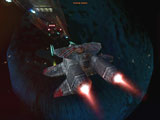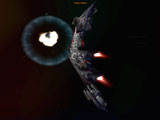 Starlancer is a direct descendent in a proud lineage stretching
back to some of the most respected games in computer gaming’s short, though
action-packed, history. The developers, Digital Anvil, have a membership that reads like a
who’s who in the gaming world; Wing Commander and Privateer 2: The Darkening should
ring some bells. So with all this talent and clout you wouldn’t be amiss in expecting
their next space combat-sim installment to be another classic. Unfortunately, a good
pedigree doesn’t necessarily make a great game. Starlancer is riddled with nagging
problems, most of which can be individually ignored, but cumulatively they hamper your
overall gaming experience. I’m not saying don’t play it, I’m just giving
you a warning not to let history set your expectations too high. Starlancer is a direct descendent in a proud lineage stretching
back to some of the most respected games in computer gaming’s short, though
action-packed, history. The developers, Digital Anvil, have a membership that reads like a
who’s who in the gaming world; Wing Commander and Privateer 2: The Darkening should
ring some bells. So with all this talent and clout you wouldn’t be amiss in expecting
their next space combat-sim installment to be another classic. Unfortunately, a good
pedigree doesn’t necessarily make a great game. Starlancer is riddled with nagging
problems, most of which can be individually ignored, but cumulatively they hamper your
overall gaming experience. I’m not saying don’t play it, I’m just giving
you a warning not to let history set your expectations too high.
 Starlancer is very story-driven, almost to a fault. There seems to have been
some sacrifice in gameplay in order to accommodate the development of the game’s
complex plot-work. The story goes that one-hundred and sixty years into the future our old
Eastern-bloc foes have once again taken up arms against the imperial dogs of the Western
world. This familiarity is key to the player’s alliance-setting tendencies, at least
for those of us that lived through and remember the heated last years of the Cold War.
Your view into the Starlancer universe is through the gradual development of the various
key players, from the conflict’s leaders to your fellow comrades in arms. This makes
for an effective if subtle immersion into the game, and the evolution of your own ideas of
the conflict are fueled by the story and in-game dialog. In a space combat-sim this is not
always the case. Often the story is either left out or so threadbare that you hardly care.
Essentially Starlancer’s narrative features both make the game more engaging and
limit your influence in the proceedings, hence the sacrifice. Starlancer is very story-driven, almost to a fault. There seems to have been
some sacrifice in gameplay in order to accommodate the development of the game’s
complex plot-work. The story goes that one-hundred and sixty years into the future our old
Eastern-bloc foes have once again taken up arms against the imperial dogs of the Western
world. This familiarity is key to the player’s alliance-setting tendencies, at least
for those of us that lived through and remember the heated last years of the Cold War.
Your view into the Starlancer universe is through the gradual development of the various
key players, from the conflict’s leaders to your fellow comrades in arms. This makes
for an effective if subtle immersion into the game, and the evolution of your own ideas of
the conflict are fueled by the story and in-game dialog. In a space combat-sim this is not
always the case. Often the story is either left out or so threadbare that you hardly care.
Essentially Starlancer’s narrative features both make the game more engaging and
limit your influence in the proceedings, hence the sacrifice.
 Starlancer has a number of control issues that may get on the player's nerves.
For example, one of my biggest pet-peeves in sim games is the inability to swap what
essentially amounts to aileron and rudder controls. In order to provide the most realistic
sensation of flight, be it atmospheric or futuristic space flight, controls should mimic
how things are in reality and are likely to remain. Moving the stick right or left should
not turn the ship but roll it, and rudder controls should not roll it but turn it. In
Starlancer you are stuck with the illogical controls. This game also has an over-abundance
of keyboard controls, most of which you will never need to use to get through the game. As
well, your ship’s heads up display is all flash and no fight, it constantly causes
problems when tracking friends or foes and the radar is nearly incomprehensible. On top of
it all, three-dimensional movement is not as effective as that of other recent games, and
barely relays the sensations that such flight should entail. Starlancer has a number of control issues that may get on the player's nerves.
For example, one of my biggest pet-peeves in sim games is the inability to swap what
essentially amounts to aileron and rudder controls. In order to provide the most realistic
sensation of flight, be it atmospheric or futuristic space flight, controls should mimic
how things are in reality and are likely to remain. Moving the stick right or left should
not turn the ship but roll it, and rudder controls should not roll it but turn it. In
Starlancer you are stuck with the illogical controls. This game also has an over-abundance
of keyboard controls, most of which you will never need to use to get through the game. As
well, your ship’s heads up display is all flash and no fight, it constantly causes
problems when tracking friends or foes and the radar is nearly incomprehensible. On top of
it all, three-dimensional movement is not as effective as that of other recent games, and
barely relays the sensations that such flight should entail.
 Another big problem is your inability to save the game from within the
missions. This is an area where I think most all space combat-sim’s could make some
improvement; after all other types of action-oriented games feature saves-on-the-fly, why
not here? Not that you necessarily need to
save often, the enemy AI is exceedingly poor, dogfights are little challenge, and your
ship’s armor and weapons are considerably more effective than your enemy’s. Some
missions, though, are exceedingly difficult because of the enemy’s numerical
advantages. Another big problem is your inability to save the game from within the
missions. This is an area where I think most all space combat-sim’s could make some
improvement; after all other types of action-oriented games feature saves-on-the-fly, why
not here? Not that you necessarily need to
save often, the enemy AI is exceedingly poor, dogfights are little challenge, and your
ship’s armor and weapons are considerably more effective than your enemy’s. Some
missions, though, are exceedingly difficult because of the enemy’s numerical
advantages.
 On
the bright side, the missions are pleasingly complex, and don’t rely on the
run-and-gun method of advancement. The story is often developed throughout the missions,
giving you a front row seat to the events affecting your game’s world. Henceforth,
the missions tend to be on the long side, which makes up for their relative scarcity. This
is where the game really shines, the combination of plot and piloting is worthy of its
Wing Commander lineage. Aside from the movement sensation the graphics are great.
Backdrops and ships are very nice looking, and are some of the best so far in the genre. On
the bright side, the missions are pleasingly complex, and don’t rely on the
run-and-gun method of advancement. The story is often developed throughout the missions,
giving you a front row seat to the events affecting your game’s world. Henceforth,
the missions tend to be on the long side, which makes up for their relative scarcity. This
is where the game really shines, the combination of plot and piloting is worthy of its
Wing Commander lineage. Aside from the movement sensation the graphics are great.
Backdrops and ships are very nice looking, and are some of the best so far in the genre.
 This
game is basically a one-shot deal—there is little replay value and no stand-alone
missions. One cool thing is the ability to advance through the missions in a multiplayer
cooperative mode. If you could manage to find someone who has picked up the game and
willing to spend the many hours of play it requires, it may be a fun option, though
necessarily logistically difficult. This
game is basically a one-shot deal—there is little replay value and no stand-alone
missions. One cool thing is the ability to advance through the missions in a multiplayer
cooperative mode. If you could manage to find someone who has picked up the game and
willing to spend the many hours of play it requires, it may be a fun option, though
necessarily logistically difficult.
Starlancer wears it’s influences on its
sleeves. That isn’t a bad thing, all computer games do it to some extent. But
tradition needs to be broken and remade in order for innovation to take place.
Unfortunately, the folks at Digital Anvil stuck to the formula and made a good game
instead of a great game.
--Thomas Hoff |
